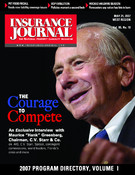The commercial insurance industry is not what it was 20 years ago. Clients present deeper risks and greater needs for cost control, and large brokerage houses and carriers are being challenged to respond. But the challenge is less about mitigating risk with the most appropriate insurance products and services — it’s more about having adequate underwriting talent to figure it all out.
Underwriting is more an art than a science, and in many ways represents the conduit to success in the commercial insurance business. Underwriters maintain relationships with producers, examine potential business, weigh risks and ultimately determine which accounts make the books. As it always was, underwriting is grounded in fundamentals yet ruled by nuances.
Not all risks in a particular class are created equal, and it takes a seasoned underwriter to know how to tackle a prospect’s business operations based on what makes them unique. The policy written for a 125-bed acute care facility would not work for a multi-location medical center. It’s an underwriter’s job to know why and to craft a program and tailor specific coverages that work.
In the past, most insurance companies drove significant investments into training, and many housed training schools to prepare and cultivate underwriting talent. The training schools of the past laid the foundation for newer underwriters who, under the tutelage of their senior counterparts, had years to learn the nuances of the various and unique classifications, exposures and risks inherent in a prospect’s business operations. We don’t see that today. Today, the products of the former training schools are moving toward retirement and will take with them their years of finely tuned intellectual capital. Filling their chairs is no easy feat — they don’t make underwriters the way they used to.
In the past three or four years, we have heard from brokers and carriers across the country that they are seeing basic flaws in transacting business that they never saw a decade ago (e.g., an underwriter relying too heavily on actuarial-based pricing models or a broker not knowing how much and which coverage to secure). With the era of the training schools behind us, we’re not only experiencing a lack of underwriting talent, but also a gap in the learning paths that exist between brokers/agents and underwriters. The reason is relatively simple — up and coming underwriters are still learning their trade.
Going forward
So what does the industry have to do going forward, and what are our options other than allocating millions of dollars to reinvent underwriting schools?
We need to foster a supportive learning environment for new underwriters and realize that it’s going to take time to rebuild the pool we had 20 years ago. We need to go back to the basics and acknowledge that production is a byproduct of experience and expertise, both of which need time to develop.
We must embrace technology. It plays a significant role in business today. Leveraging technology, such as Internet-based line guides and risk assessment programs, can expedite the learning curve and give inexperienced underwriters a much-needed leg up. We can further support promising underwriters by looking to our retiring underwriters as mentors and advisors. In the past, a career underwriter would retire and be replaced comfortably with those they had trained. Today, carriers are recognizing their potential as mentors and look for creative ways to access their knowledge to help groom young talent.
Path to success
The path to becoming a successful underwriter takes commitment, drive, hard work and determination.
Recent college graduates represent the “now generation” and operate in the digital age of instant gratification. As a result, many expect to move quickly through the ranks and look to companies that will afford them opportunities to succeed and provide meaningful rewards when they do. Underwriting commercial insurance can offer new graduates a tremendous career opportunity, but the career prospect needs to be aligned with the expectations of a different generation. In short, it’s not just about getting new underwriters onboard, but also about supporting their careers and keeping them around long enough to experience success.
College graduates are no longer entering into insurance company training programs with plans to surf the underwriting wave to retirement. Today, the underwriting employment pool is extremely small and competitive, and it looks to stay that way for some time. And because the pool is so small, its constituents can afford to be selective. They look for companies who promote work/life balance, who value ethics and who support their career needs. We’re not likely to sell underwriting to this dwindling talent pool using the techniques of the past, so it’s clearly time to redefine a new approach to attracting and developing this talent.
Underwriting can still be one of the most challenging and fulfilling career opportunities in the financial services industry. It’s up to us, however, to ensure the landscape aligns with the expectations and desires of a new generation.
Kyle Morhardt is vice president, Risk Management Services, and Andy McGill is vice president, Human Resources for The PMA Insurance Group. Web site: www.pmagroup.com.
Was this article valuable?
Here are more articles you may enjoy.


 Law Firm Faces Sanctions for Failing to Vet Ugandan Claims in $6B 3M Case
Law Firm Faces Sanctions for Failing to Vet Ugandan Claims in $6B 3M Case  Alliant Latest to Sue Howden US Over Alleged ‘Smash-and-Grab’ Poaching
Alliant Latest to Sue Howden US Over Alleged ‘Smash-and-Grab’ Poaching  AIG’s Zaffino to Step Down as CEO as Aon’s Andersen Steps In
AIG’s Zaffino to Step Down as CEO as Aon’s Andersen Steps In  CEOs on Guard as Trump Rattles Companies With Series of Edicts
CEOs on Guard as Trump Rattles Companies With Series of Edicts 


